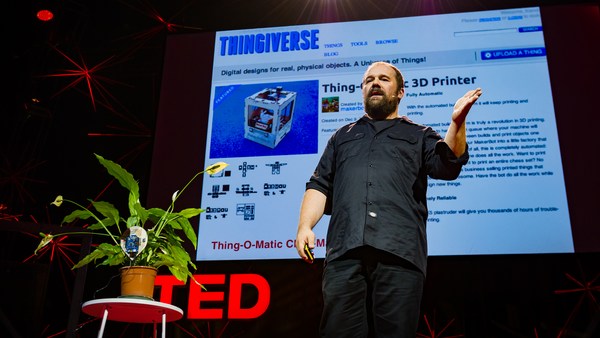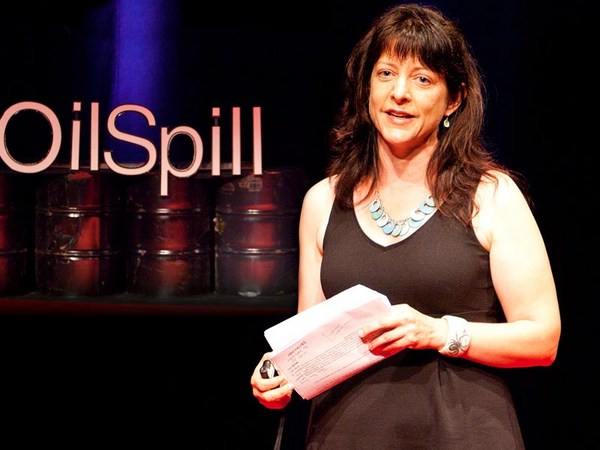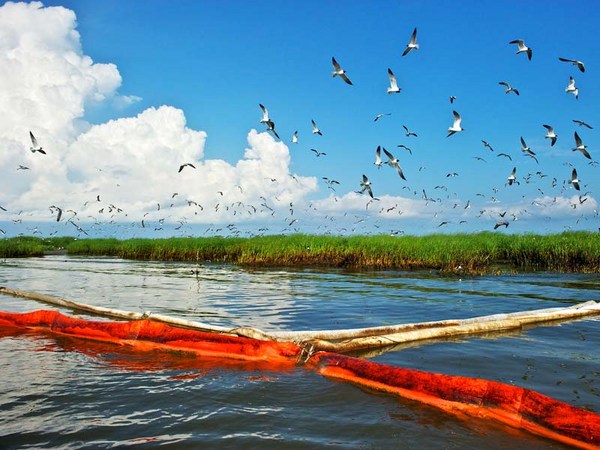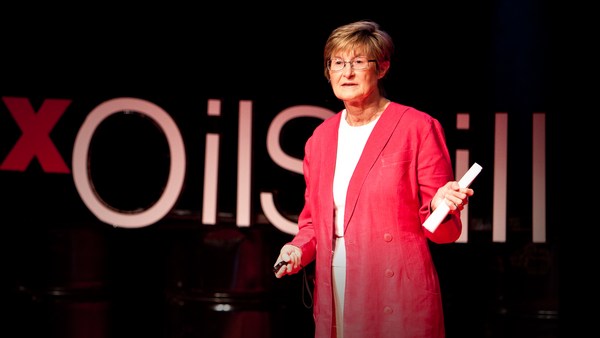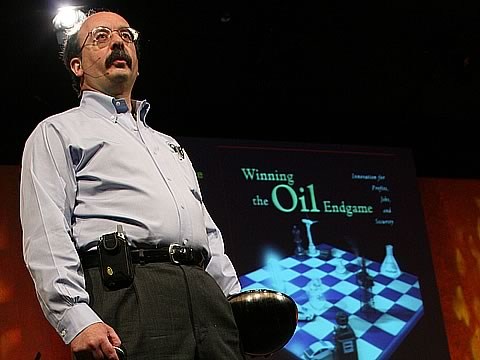In the ocean, what is the common point between oil, plastic and radioactivity?
On the top line, this is the BP oil spill: billions of barrels of oil gushing in the Gulf of Mexico. The middle line is millions of tons of plastic debris accumulating in our ocean, and the third line is radioactive material leaking from Fukushima nuclear power plant in the Pacific Ocean.
Well, the three big problems have in common that they are man-made problems but they are controlled by natural forces. This should make us feel very, terribly awful as much as it should make us feel hopeful, because if we have the power to create these problems, we may as well have the power to remediate these problems.
But what about natural forces? Well, that's exactly what I want to talk about today, is how we can use these natural forces to remediate these man-made problems. When the BP oil spill happened,
I was working at MIT, and I was in charge of developing an oil spill-cleaning technology. And I had a chance to go in the Gulf of Mexico and meet some fishermen and see the terrible conditions in which they were working. More than 700 of these boats, which are fishermen boats repurposed with oil absorbent in white and oil containment in orange, were used, but they only collected three percent of the oil on the surface, and the health of the cleaners were very deeply affected.
I was working on a very interesting technology at MIT, but it was a very long-term view of how to develop technology, and it was going to be a very expensive technology, and also it would be patented. So I wanted to develop something that we could develop very fast, that would be cheap, and that would be open-source, so, because oil spills are not only happening in the Gulf of Mexico, and that would be using renewable energy. So I quit my dream job, and I moved to New Orleans, and I kept on studying how the oil spill was happening.
Currently, what they were doing is that they were using these small fishing boats, and they were cleaning clean lines in an ocean of dirt. If you're using the exact same amount of surface of oil absorbent, but you're just paying attention to natural patterns, and if you're going up the winds, you can collect a lot more material. If you're multiplying the rig, so you multiply how many layers of absorbent you're using, you can collect a lot more. But it's extremely difficult to move oil absorbent against the winds, the surface currents and the waves. These are enormous forces. So the very simple idea was to use the ancient technique of sailing and tacking of the wind to capture or intercept the oil that is drifting down the wind. So this didn't require any invention. We just took a simple sailing boat and we tried to pull something long and heavy, but as we tacked back and forth, what we lost was two things: we were losing pulling power and direction.
And so, I thought, what about if we just take the rudder from the back of the boat to the front, would we have better control? So I built this small sailing robot with the rudder at the front, and I was trying to pull something very long and heavy, so that's a four-meter-long object just to pull, and I was surprised with just a 14-centimeter rudder, I could control four meters of absorbent. Then I was so happy that I kept playing with the robot, and so you see the robot has a front rudder here. Normally it's at the back. And, playing, I realized that the maneuverability of this was really amazing, and I could avoid an obstacle at the very last second, more maneuverable than a normal boat.
Then I started publishing online, and some friends from Korea, they started being interested in this, and we made a boat which has a front rudder and a back rudder, so we started interacting with this, and it was slightly better, although it was very small and a bit off balance, but then we thought, what if we have more than two points of control? What if the entire boat becomes a point of control? What if the entire boat changes shape?
So — (Applause)
Thank you very much. (Applause)
And so that's the beginning of Protei, and that's the first boat in history that completely changed the shape of the hull in order to control it, and the properties of sailing that we get are very superior compared to a normal boat. When we're turning, we have the feeling of surfing, and the way it's going up-wind, it's very efficient. This is low speed, low wind speed, and the maneuverability is very increased, and here I'm going to do a small jibe, and look at the position of the sail. What's happening is that, because the boat changes shape, the position of the front sail and the main sail are different to the wind. We're catching wind from both sides. And this is exactly what we're looking [for] if we want to pull something long and heavy. We don't want to lose pulling power, nor direction. So, I wanted to know if this was possible to put this at an industrial level, so we made a large boat with a large sail, and with a very light hull, inflatable, very small footprint, so we have a very big size and power ratio.
After this, we wanted to see if we could implement this and automate the system, so we used the same system but we added a structure to it so we could activate the machine. So, we used the same bladder-inflated system, and we took it for testing. So this is happening in the Netherlands. We tried in the water without any skin or ballast just to see how it works. And then we mounted a camera for controlling it, but quickly we saw that we would need a lot more weight at the bottom, so we had to take it back to the lab, and then we built a skin around it, we put batteries, remote controllers, and then we put it in the water and then we let it go in the water and see how well it would work, so let some rope out, and hope it's going to work, and it worked okay, but we still have a long way. Our small prototype has given us good insight that it's working very well, but we still need to work a lot more on this.
So what we are doing is an accelerated evolution of sailing technology. We went from a back rudder to a front rudder to two rudders to multiple rudders to the whole boat changing shape, and the more we are moving forward, and the more the design looks simple and cute. (Laughter)
But I wanted to show you a fish because -- In fact, it's very different from a fish. A fish will move because -- by changing like this, but our boat is propelled by the wind still, and the hull controls the trajectory.
So I brought to you for the first time on the TED stage Protei Number Eight. It's not the last one, but it's a good one for making demos.
So the first thing as I show you in the video is that we may be able to control the trajectory of a sailing boat better, or we may be able to never be in irons, so never facing the wind, we always can catch the wind from both sides. But new properties of a sailing boat. So if you're looking at the boat from this side, this might remind you of an airplane profile. An airplane, when you're moving in this direction, starts to lift, and that's how it takes off. Now, if you're taking the same system, and you're putting vertical, you're bending, and if you're moving this way forward, your instinct will tell you that you might go this way, but if you're moving fast enough, you might create what we call lateral lift, so we could get further or closer to the wind.
Other property is this: A normal sailing boat has a centerboard here and a rudder at the back, and these two things are what creates most resistance and turbulence behind the boat, but because this doesn't have either a centerboard or a rudder, we hope that if we keep working on this hull design we can improve and have less resistance.
The other thing is, most boats, when they reach a certain speed, and they are going on waves, they start to hit and slap on the surface of the water, and a lot of the energy moving forward is lost. But if we're going with the flow, if we pay attention to natural patterns instead of trying to be strong, but if you're going with the flow, we may absorb a lot of environmental noises, so the wave energy, to actually save some energy to move forward.
So we may have developed the technology which is very efficient for pulling something long and heavy, but the idea is, what is the purpose of technology if it doesn't reach the right hands?
Normal technology or innovation happens like this: Somebody has an interesting idea, some other scientist or engineer, they take it to the next level, they make a theory about it and maybe they patent it, and then some industry will make a contract of exclusivity to manufacture and sell it, and then, eventually, a buyer will buy it, and we hope that they are going to use [it] for a good purpose. What we really want is that this innovation happens continuously. The inventor and engineers and also the manufacturers and everybody works at the same time, but this would be sterile if this was happening in a parallel and uncrossed process. What you really want is not a sequential, not parallel development. You want to have a network of innovation. You want everybody, like we're doing now, to work at the same time, and that can only happen if these people all together decide to share the information, and that's exactly what open hardware is about. It's to replace competition by collaboration. It's to transform any new product into a new market. So what is open hardware? Essentially, open hardware is a license. It's just an intellectual property setup. It means that everybody is free to use, modify and distribute, and in exchange we only ask for two things: The name is credited -- the name of the project -- and also the people who make improvement, they share back with the community. So it's a very simple condition.
And I started this project alone in a garage in New Orleans, but quickly after I wanted to publish and share this information, so I made a Kickstarter, which is a crowd-fundraising platform, and in about one month we fundraised 30,000 dollars. With this money, I hired a team of young engineers from all over the world, and we rented a factory in Rotterdam in the Netherlands. We were peer-learning, we were engineering, we were making things, prototyping, but most importantly we were trying our prototypes in the water as often as possible, to fail as quickly as possible, to learn from. This is a proud member of Protei from Korea, and on the right side, this is a multiple-masts design proposed by a team in Mexico. This idea really appealed to Gabriella Levine in New York, and so she decided to prototype this idea that she saw, and she documented every step of the process, and she published it on Instructables, which is a website for sharing inventions. Less than one week after, this is a team in Eindhoven, it's a school of engineering. They made it, but they eventually published a simplified design. They also made it into an Instructable, and in less than one week, they had almost 10,000 views, and they got many new friends. We're working on also simpler technology, not that complex, with younger people and also older people, like this dinosaur is from Mexico. (Laughter)
So Protei is now an international network of innovation for selling technology using this shape-shifting hull. And what puts us together is that we have a common, at least, global understanding of what the word "business" is, or what it should be. This is how most work today. Business as usual is saying, what's most important is to make lots of profit, and you'll be using technology for that, and people will be your work force, instrumentalized, and environment is usually the last priority. It will be just a way to, say, greenwash your audience and, say, increase your price tag.
What we're trying to do, or what we believe, because this is how we believe the world really works, is that without the environment you have nothing. We have the people so we need to protect each other, yes, and we're a technology company, and profit is necessary to make this happen. (Applause)
Thank you very much. (Applause)
If we have the courage to understand or accept that this actually how the world really works, and this is the order of priority that we need to choose, then it makes obvious why we need to choose open hardware for developing environmental technology, because we need to share information.
What's next for us?
So, this small machine that you've seen, we're hoping to make small toys like one-meter remote control Protei that you can upgrade -- so replace the remote control parts by Androids, so the mobile phone, and Arduino micro-controller, so you could be controlling this from your mobile phone, your tablet. Then what we want to do is create six-meter versions so we can test the maximum performance of these machines, so we can go at very, very high speed. So imagine yourself. You are laying down in a flexible torpedo, sailing at high speed, controlling the shape of the hull with your legs and controlling the sail with your arms. So that's what we're looking for developing. (Applause)
And we replace the human being -- to go, for example, for measuring radioactivity, you don't want a human to be sailing those robots -- with batteries, motors, micro-controllers and sensors. This is what our teammates, we dream of at night. We hope that we can sometime clean up oil spills, or we can gather or collect plastic in the ocean, or we can have swarms of our machines controlled by multi-player video game engines to control many of these machines, to monitor coral reefs or to monitor fisheries.
Our hope is that we can use open hardware technology to better understand and protect our oceans.
Thank you very much. (Applause) (Applause)
